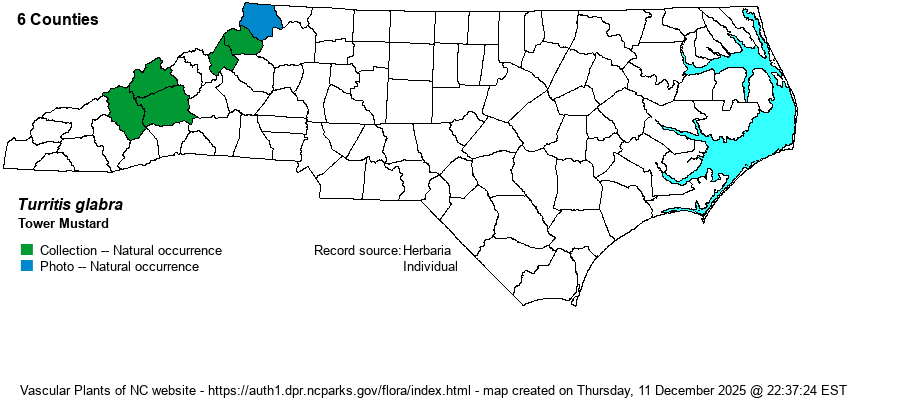| Author | L. | |
| Distribution | Present only in the Mountains, known from six counties in the northern and central parts of the province.
This is a widespread Northern and Western species, ranging south to PA and IL, and mainly southward in the Appalachians to western NC and TN.
| |
| Abundance | Now very rare; known from a handful of locations. One was discovered in June 2024 in Ashe County by Harry LeGrand (photos by Lori Arent are below). This is a State Endangered species. | |
| Habitat | This is a species of high elevation openings, such as meadows, wooded borders, and fields, typically in disturbed areas. | |
| Phenology | Blooms from May to June, and fruits from July to August. | |
| Identification | This is a very tall mustard, typically 3-4 feet tall. It is erect but generally unbranched, somewhat gray-green and waxy. There is a group of basal leaves, mostly elliptical and hairy, but these usually wither before flowering. The many alternate leaves are strongly ascending to almost appressed to the stem, generally with strongly clasping bases with auricles, such that the leaves resemble arrowheads. The inflorescence at the end of the stem is a group of racemes of flowers, each flower being creamy-yellow/white in color, with 4 petals and a spread of about 1/2-inch. Very obvious are the numerous fruit, as the siliques are very narrow but about 3 inches long, not only ascending but practically hugging the stem. Thus, this species should not be confused -- very tall, with narrow arrowhead leaves clasping the stem, creamy flowers, and long and erect siliques. | |
| Taxonomic Comments | This species was long known as Arabis glabra.
| |
| Other Common Name(s) | Tower Rockcress | |
| State Rank | S1 | |
| Global Rank | G5 | |
| State Status | E | |
| US Status | | |
| USACE-agcp | | |
| USACE-emp | | |

